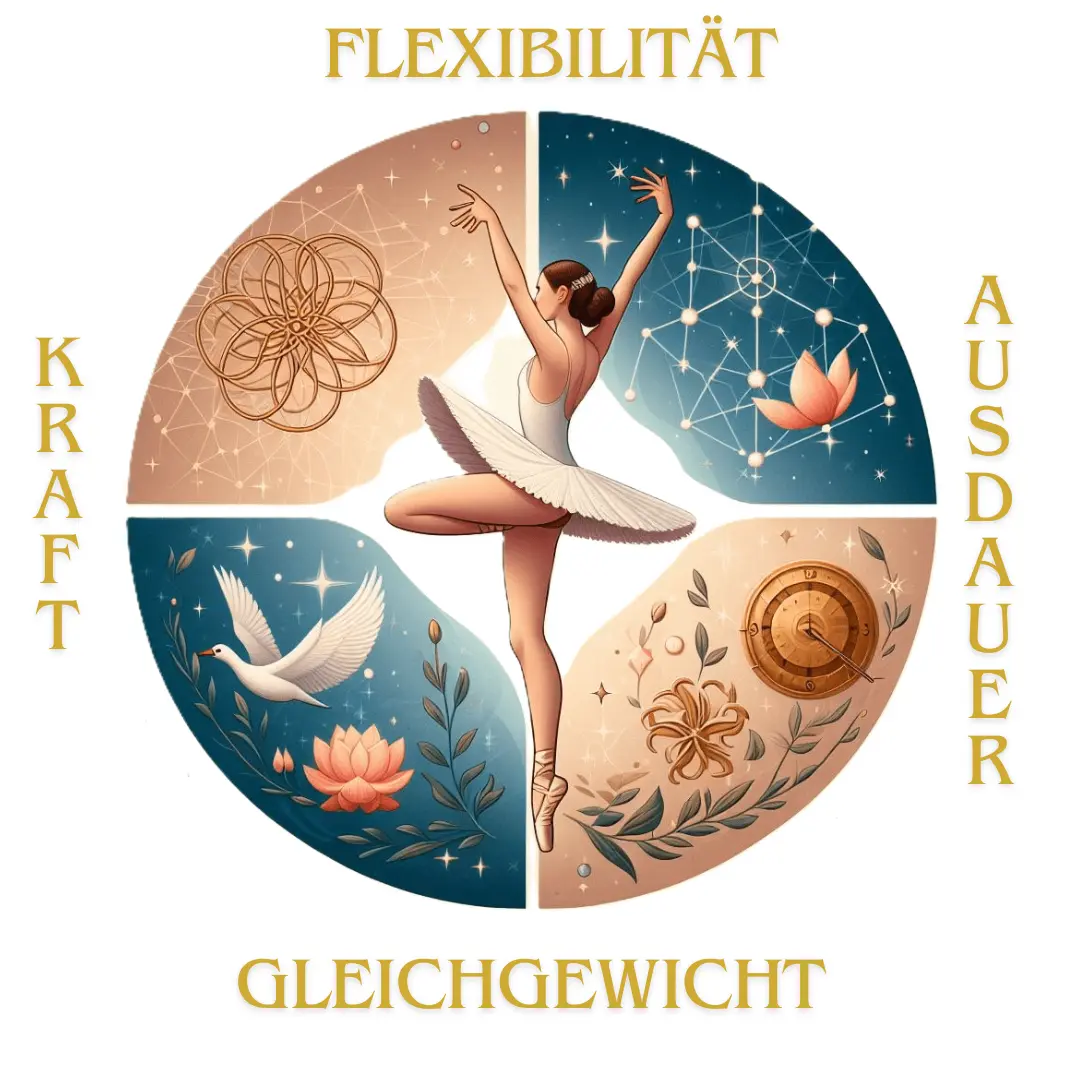
Take a short self-test and identify any deficits. You can then improve these in a targeted manner
By Olga Leibrandt · Last updated: June 1, 2024 · Information Ballet · ⏱ 4 min. reading time
This ballet fitness calculator will help you determine your fitness for ballet. It is aimed at ballet students with basic ballet knowledge. Simply enter your scores for flexibility, balance, endurance and strength. The tool will then show you a score of your ballet fitness. This ranges from less than 6, which indicates a need for improvement, to more than 9, which means excellent fitness.
The calculator’s result not only offers you an assessment of your current ballet fitness. It also gives you personalized recommendations and training suggestions to improve your fitness and strengthen your ballet skills. Use this information to work specifically on your weaknesses and optimize your dance performance.
Ready to take your ballet fitness to the next level? Enter your scores (each from 1-10) and discover where you can improve!
Ballet Fitness Calculator:
(1: Stiff, 10: Very flexible)
(1: Unbalanced, 10: Very balanced)
(1: Weak, 10: Very strong)
(1: Low Stamina, 10: High Stamina)
Why these criteria?
Flexibility, balance, endurance and strength are very important in ballet. They are the cornerstone of overall fitness and a prerequisite for successful ballet practice.
- Flexibility : Allows large ranges of motion and reduces the risk of injury.
- Balance : Provides stability and precision in movements.
- Endurance : Essential for energetic movements and long dance phases.
- Strength : Supports posture, enables powerful jumps and improves muscle control.
Together, these skills form the basis for an elegant and powerful dance technique.
How do I improve my flexibility?
Flexibility is an important aspect of ballet. It allows dancers to perform elegant movements with ease. To improve flexibility, regular stretching is necessary. Stretching exercises such as splits , leg extensions, and back bends help to lengthen muscles and increase range of motion. Stretch slowly and in a controlled manner to avoid injury . Yoga and Pilates also help to increase flexibility while strengthening muscles. Consistency is key to achieving long-term improvements. I recommend working on flexibility exercises regularly and incorporating them into your daily ballet training.

Fig. Exercise with cross splits
| Techniques to improve flexibility | Description |
|---|---|
| Targeted stretches | In addition to the classic stretching exercises, you should also perform targeted stretches for certain muscle groups that are particularly stressed in ballet , such as the leg and back muscles. An individually tailored stretching program will help you to target specific areas. |
| Progressives Training | The stretching regimen should be continually increased to achieve long-term progress. This can be done by adding intensity, duration or number of repetitions. A slow and steady approach allows for safe and effective improvement in flexibility. |
| Breathing techniques | Using correct breathing techniques while stretching improves the effectiveness of the stretching exercises and promotes relaxation at the same time. By consciously breathing in and out, muscle tension is released and the stretch is deepened. |
| Supportive tools | If necessary, use props such as yoga blocks, stretching bands, or foam rollers to assist with the stretches and ensure safe execution. These props will help you deepen the stretch while preventing injury. |
| Regeneration | Take a break after stretching. Give your muscles time to recover. Adequate rest and relaxation, as well as a balanced diet and adequate hydration, support the process of improving flexibility and contribute to overall health. |
How do I improve my balance?
Good balance is crucial for a precise and elegant ballet performance. To improve balance, you can perform special exercises that promote stability and body control. One-legged exercises such as arabesques and relevés help you train your balance and strengthen the muscles required for an upright posture and stable positions.
Practicing on unstable surfaces such as a balance cushion or a Bosu ball also helps to improve balance. By practicing on unstable surfaces, you challenge the stabilizing muscles and promote proprioception.
Proprioception is the perception of one’s own body according to its position in space, the positions of the head, torso and limbs in relation to each other and their changes as movements, including the sensation of heaviness, tension, power and speed Wikipedia . A conscious body awareness and an upright posture are also important to improve balance in ballet. Through regular training and targeted exercises, dancers can improve their balance and increase their performance on stage. Exercises for this.

Fig. Exercise with balance cushion
| Exercise | Description |
|---|---|
| Konzentrationsübungen | Concentration is helpful for good balance. Through targeted concentration exercises and meditation techniques, dancers can direct their attention and mindfulness to the moment. This helps them maintain their balance and minimize distractions. |
| Eye focus | Focusing the eyes on a specific point in space helps stabilize balance and improve body alignment. Dancers learn to keep their gaze fixed on a fixed point while moving or standing on one leg to optimize their balance. |
| Correction of posture and alignment | Proper body alignment and posture also help you with balance. By maintaining a strong and upright posture and a balanced distribution of body weight, dancers improve their balance and avoid unstable positions. |
| Progressives Training | Balance training should be increased gradually so that you can continually improve your stability and control. This can be done by adding more complex exercises, longer holds or using unstable surfaces to increase the challenge and further develop the dancer’s skills. |
| Integration into ballet training | Balance training should be considered an integral part of ballet training and should be regularly integrated into practice. By combining balance exercises with other ballet techniques, dancers can improve their skills holistically and achieve a stable and elegant performance on stage. |
How do I improve my strength?
To improve strength for ballet, strength training can help. This includes exercises that strengthen the main muscle groups used in ballet, such as the legs, arms, back, and core. Examples of such exercises are pliés , lunges, push-ups, planks, and back extensions.
It is a good idea to train with both your own body weight and additional weights in order to achieve a progressive load and therefore an increase in strength.
In addition, specific ballet exercises such as relevés, développés, and port de bras help to improve muscle strength, particularly stability and power in the feet, legs, and arms. A balanced diet with sufficient protein is also useful to support muscle building and aid recovery after training. Through consistent and targeted strength training, ballet dancers can increase their strength and improve their performance on stage.

Fig. Exercise Demi Pliés in 1st position
| Exercise | Description |
|---|---|
| Half Pliés in 1. Position | This exercise strengthens the legs and core by activating the muscles in the thighs, glutes and lower back. Get into ballet position 1 (heels together, toes turned out) and perform half squats. More under exercises at home . |
| pushups | Push-ups are a great exercise to strengthen your arm and chest muscles. Start in a push-up position with your hands slightly wider than shoulder-width apart and lower your body by bending your arms until your chest almost touches the floor, then push yourself back up. |
| Planks | Planks target the core muscles and improve stability and endurance of the abdominals, lower back and shoulders. Hold your body position in a push-up position with your forearms and toes touching the floor and your body forming a straight line. |
| Statements | Relevés are up and down movements on the tiptoes that strengthen the muscles in the feet, legs and calves. Perform this exercise by rising up on your tiptoes and then slowly lowering yourself back down. |
How do I improve my endurance?
Good endurance is a prerequisite for a powerful and dynamic ballet performance. To improve endurance, regular cardiovascular training can help. This includes activities such as running, swimming or cycling, which strengthen the cardiovascular system and increase lung capacity.
In addition, specific ballet exercises such as allegro combinations and jump rows can also help to improve endurance, as they require a continuous supply of energy.
Targeted interval training , which combines short, intense exercise phases with short recovery phases, can also help to increase endurance. A balanced diet that provides sufficient energy to cope with the physical strain during training is also important. Through a combination of targeted training, regular physical activity and a healthy lifestyle, dancers improve their endurance and increase their performance.

Fig. Exercise with bicycle trainer
| Training method | Description |
|---|---|
| Cardiovascular training | Regularly engaging in activities such as running, swimming or cycling to strengthen the cardiovascular system, improve lung capacity and promote overall endurance. |
| Ballet-specific exercises | Performing ballet exercises such as allegro combinations and jump sequences to increase endurance. These exercises require a continuous supply of energy and promote the ability to dance powerfully for longer periods of time. |
| Interval training | Conducting targeted interval training that combines short periods of intense exercise with short recovery periods to effectively increase endurance and improve the ability to recover quickly between bouts of exertion. |
| Balanced nutrition | Eat a balanced diet. You need enough energy to cope with the physical strain of training. Make sure you consume enough carbohydrates, proteins and healthy fats for an optimal energy source. Find out more at Palucca.eu . |
